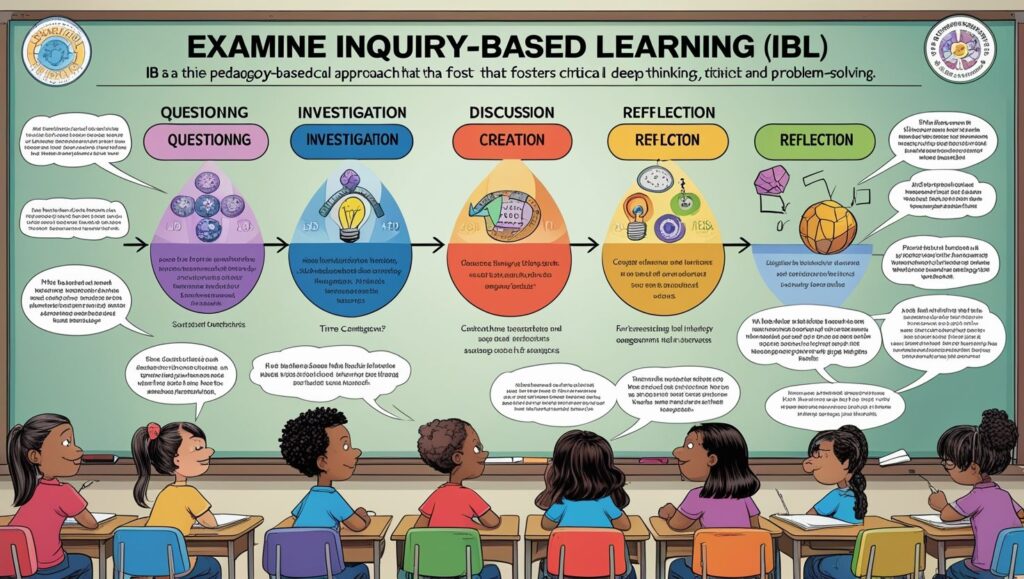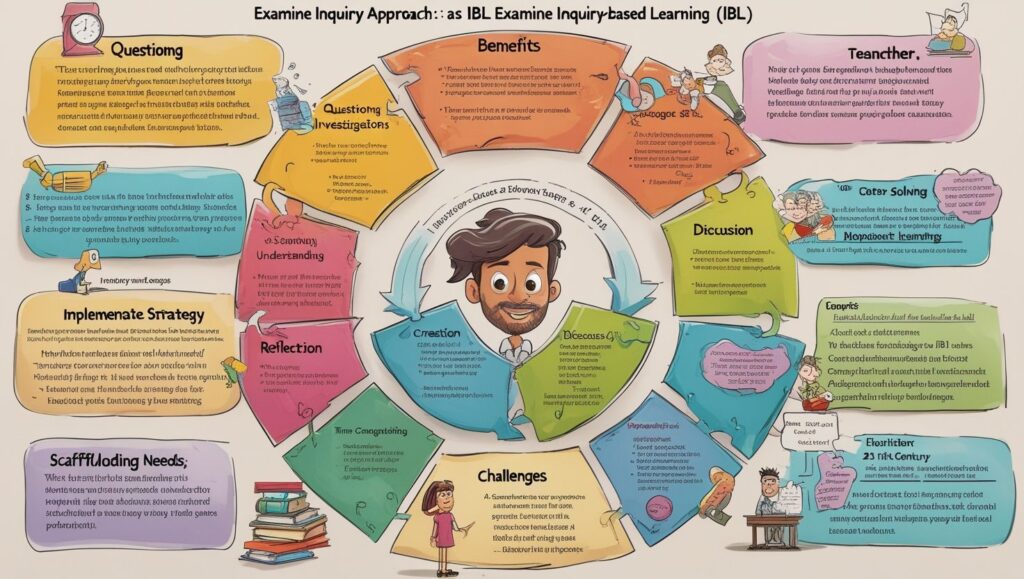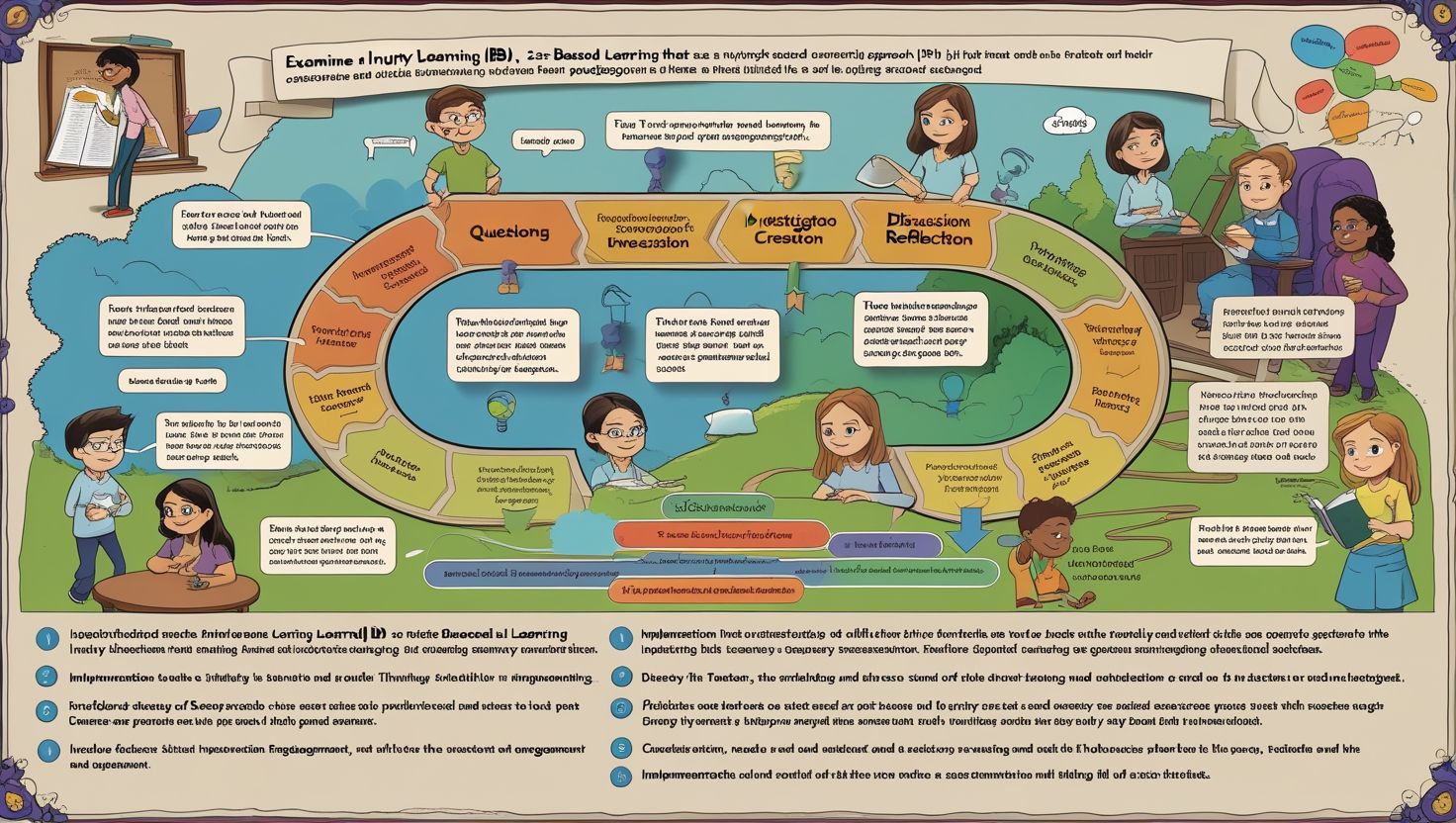Abstract
Inquiry-Based Learning and Thinking in Education, Inquiry-Based Learning (IBL) is a student-centered approach that encourages learners to ask questions, investigate, and construct their own understanding. Rooted in constructivist theories of education, IBL transforms classrooms into dynamic environments where students take ownership of their learning. This article explores the theoretical foundation, core principles, implementation strategies, benefits, and challenges of inquiry-based learning. By promoting critical thinking, collaboration, and lifelong curiosity, IBL has the potential to revolutionize traditional teaching methods and better prepare students for the complexities of the modern world.
1. Introduction
Traditional education has often focused on the passive transfer of knowledge from teacher to student. However, with the advent of 21st-century skills and the increasing need for innovation, education is shifting toward more active and engaging methods of instruction. One such approach is Inquiry-Based Learning (IBL), which places students at the center of the learning process and fosters their innate curiosity.
IBL encourages students to explore topics, ask meaningful questions, conduct investigations, and derive conclusions based on evidence. It mirrors the methods of scientists, historians, and researchers, thereby equipping students with skills that transcend academic subjects. This article delves into the nature and value of inquiry-based learning in modern education.
2. Theoretical Foundations of Inquiry-Based Learning
Inquiry-based learning is grounded in constructivist learning theory, notably advanced by Jean Piaget and Lev Vygotsky. Constructivism posits that learners actively build their knowledge through experiences and reflections rather than passively receiving information.
- Piaget emphasized that learners progress through stages of cognitive development and learn best through hands-on experiences.
- Vygotsky introduced the idea of the Zone of Proximal Development (ZPD), suggesting that learning occurs most effectively when students are guided by a more knowledgeable individual (such as a teacher or peer) while solving challenging tasks.
Additionally, John Dewey, a pioneer in progressive education, advocated for experiential learning and the role of inquiry in developing democratic and reflective thinkers. Dewey believed that education should be based on the principle of learning through doing, with students engaging in real-world problems.

3. Core Principles of Inquiry-Based Learning
Inquiry-based learning follows several core principles that distinguish it from traditional instruction:
- Student-Centered Learning: Students take an active role, with teachers serving as facilitators or guides rather than sole sources of knowledge.
- Question-Driven Instruction: Learning begins with a question, problem, or scenario posed by the teacher or students.
- Investigation and Research: Students gather information, test hypotheses, and analyze results.
- Collaboration and Communication: Inquiry often involves group work, peer discussions, and sharing of findings.
- Reflection and Metacognition: Students reflect on their learning process and the conclusions they draw.
- Authentic Assessment: Evaluation focuses on process and performance rather than just final answers.
These principles align with the goals of developing critical thinkers who are capable of navigating a complex, information-rich world.
4. Types of Inquiry-Based Learning
IBL can be implemented through various levels of student autonomy:
4.1 Structured Inquiry
The teacher provides a clear question and the method for investigation. Students follow specific instructions to discover answers. This is often used in science labs or beginner-level IBL.
4.2 Guided Inquiry
The teacher provides the question, but students determine how to conduct the investigation. This allows for more autonomy and creativity.
4.3 Open Inquiry
Students formulate their own questions and investigation methods. This approach encourages independence and is typically used with experienced learners.
4.4 Project-Based Learning (PBL)
A form of inquiry learning where students investigate real-world problems over an extended period, culminating in a project or presentation.
5. Steps in the Inquiry Process
While the inquiry cycle may vary, it generally involves the following stages:
- Questioning: Students or teachers pose a thought-provoking question.
- Planning: Students design an investigation strategy or research plan.
- Exploring and Investigating: Data is collected through experiments, research, surveys, or observations.
- Analyzing and Synthesizing: Students examine the data, look for patterns, and draw conclusions.
- Presenting and Sharing: Findings are communicated to peers, teachers, or a broader audience.
- Reflecting and Revising: Students reflect on their learning and consider areas for improvement or further inquiry.
6. Implementing Inquiry-Based Learning in the Classroom
Effective implementation of IBL requires thoughtful planning and a shift in teacher mindset. Below are strategies for successful integration:
6.1 Cultivating a Questioning Culture
Teachers must model curiosity and encourage students to ask “how” and “why” questions. Tools like the Question Formulation Technique (QFT) can help students develop inquiry skills.
6.2 Creating a Safe Learning Environment
Students need a supportive classroom climate where their ideas are respected, and mistakes are seen as learning opportunities.
6.3 Scaffolding the Inquiry Process
Teachers should provide structure and gradually release responsibility as students gain confidence. Graphic organizers, research templates, and checklists can help.
6.4 Integrating Technology
Digital tools like Google Forms, Padlet, Jamboard, and data analysis apps can enhance investigations and presentations.
6.5 Cross-Disciplinary Projects
IBL works well when connecting multiple subject areas, such as combining science, math, and social studies in a community-based inquiry project.

7. Benefits of Inquiry-Based Learning
7.1 Promotes Deeper Understanding
Rather than memorizing facts, students explore concepts in depth, leading to better retention and application.
7.2 Enhances Critical Thinking and Problem-Solving
IBL requires students to analyze, synthesize, and evaluate information—key components of higher-order thinking.
7.3 Fosters Student Engagement and Motivation
Students are more invested in learning when they explore topics that interest them and have autonomy in the learning process.
7.4 Encourages Collaboration and Communication
Inquiry projects often involve group work, building teamwork, and interpersonal skills.
7.5 Supports Lifelong Learning
IBL instills habits of curiosity, research, and reflection that extend beyond the classroom.
Research by Zion & Mendelovici (2012) shows that students in inquiry-based classrooms outperform their peers in conceptual understanding and self-directed learning skills.
8. Challenges and Limitations
Despite its advantages, IBL presents several challenges:
8.1 Time Constraints
Inquiry projects can be time-consuming, making it difficult to cover a broad curriculum.
8.2 Assessment Difficulties
Traditional assessments may not effectively measure the skills developed through IBL. Teachers must use rubrics, portfolios, and performance assessments.
8.3 Classroom Management
Facilitating inquiry in a dynamic environment requires strong management skills and clear expectations.
8.4 Uneven Student Participation
Some students may struggle with the autonomy and open-ended nature of inquiry. Teachers need to provide targeted support.
8.5 Teacher Preparedness
Not all educators are trained in inquiry methodologies. Ongoing professional development is essential for effective implementation.
9. Inquiry-Based Learning Across Subjects
9.1 Science
IBL aligns naturally with scientific methods. Students can design experiments, test hypotheses, and analyze results.
9.2 Mathematics
Through real-world problems and data analysis, students apply mathematical reasoning in meaningful contexts.
9.3 Social Studies
Students explore historical events or societal issues through primary sources, debates, and simulations.
9.4 Language Arts
IBL in reading and writing involves literary analysis, author studies, and research-based writing.
9.5 Art and Design
Creative inquiry encourages students to explore materials, techniques, and artistic themes.
10. Inquiry in the Digital Age
Digital inquiry expands the possibilities for research, collaboration, and global connection. Students can:
- Access vast online databases and resources.
- Collaborate with peers across the globe through virtual classrooms.
- Create digital artifacts such as infographics, videos, and blogs to share findings.
Platforms like Google Scholar, Flipgrid, Canva, and virtual labs make digital inquiry more engaging and accessible. Educators must also teach digital literacy and critical evaluation of sources.
11. Inquiry-Based Learning and Equity
When implemented thoughtfully, IBL can promote educational equity:
- Culturally relevant inquiries empower students from diverse backgrounds.
- Choice and voice in projects allow students to bring their experiences into the classroom.
- Differentiation ensures all learners, including those or language barriers, can participate meaningfully.
Teachers must remain vigilant to ensure all students have access to resources, guidance, and support in inquiry-based environments.
12. Professional Development for Teachers
Effective use of IBL requires targeted training. Schools should invest in:
- Workshops and courses on inquiry strategies.
- Collaborative planning time for teachers.
- Mentoring and coaching models.
- Sharing of best practices through teacher networks and learning communities.
Professional learning communities (PLCs) can provide platforms for reflection, idea exchange, and collective inquiry into teaching practices.
13. Future Directions in Inquiry-Based Learning
As education continues to evolve, IBL will play a vital role in developing future-ready learners. Key trends include:
- Integration of Artificial Intelligence (AI) for personalized inquiries.
- Emphasis on sustainability and global citizenship in inquiry topics.
- Expansion of interdisciplinary STEM/STEAM inquiry projects.
- Increased focus on student-led research and capstone projects in secondary education.
As societies face complex global challenges, inquiry-based learning equips students with the mindset and tools to innovate, empathize, and act responsibly.
14. Conclusion
Inquiry-Based Learning represents a transformative approach to education—one that prioritizes curiosity, exploration, and critical thinking. By allowing students to take ownership of their learning journey, IBL cultivates not only academic success but also the competencies needed in a rapidly changing world. While challenges exist, the benefits of inquiry—engagement, deeper understanding, and lifelong learning—make it a worthwhile endeavor for educators committed to meaningful and equitable education.
To fully realize the potential of inquiry-based learning, schools must invest in supportive infrastructure, teacher training, and a culture that values questions as much as answers.
References
- Dewey, J. (1938). Experience and Education. New York: Macmillan.
- Piaget, J. (1970). Science of Education and the Psychology of the Child. New York: Viking Press.
- Vygotsky, L. S. (1978). Mind in Society: The Development of Higher Psychological Processes. Harvard University Press.
- Zion, M., & Mendelovici, R. (2012). Moving from structured to open inquiry: Challenges and limits. Science Education International, 23(4), 383–399.
- Bell, R. L., Smetana, L., & Binns, I. (2005). Simplifying Inquiry Instruction. The Science Teacher, 72(7), 30–33.
- Barron, B., & Darling-Hammond, L. (2008). Teaching for meaningful learning: A review of research on inquiry-based and cooperative learning. In Powerful Learning (pp. 11–70). Jossey-Bass.
- National Research Council. (2000). Inquiry and the National Science Education Standards: A Guide for Teaching and Learning. Washington, DC: National Academies Press.

hacklink satın al buyhacklink.com google seo hacklink buyhacklink.com https://www.kusadasiteksex.com/
hacklink fiyatları buyhacklink.com etkili buyhacklink.com https://www.jadekusadasi.com/
Kaliteli Hacklink Satış Paneli buyhacklink.com buyhacklink.com https://www.jadekusadasi.com/
Esenyurt su kaçağı tespiti Bireysel ve Ticari Çözümler: Hem evde hem de iş yerinde bu hizmeti aldık, her ikisinde de çok başarılıydılar. https://todopescagalicia.es/?p=22140